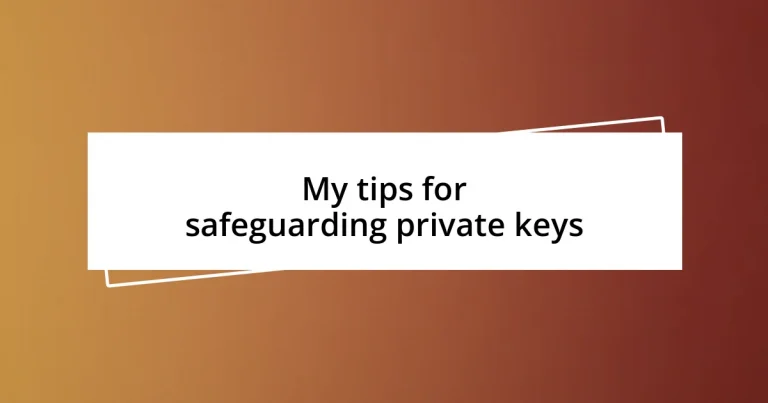Key takeaways:
- Private keys are essential for securing digital assets; losing them can result in the permanent loss of funds.
- Common risks include phishing attacks, malware, and physical theft, emphasizing the need for vigilance and robust security practices.
- Implementing strategies like using hardware wallets, maintaining backups, and keeping software updated are critical for effective private key management.
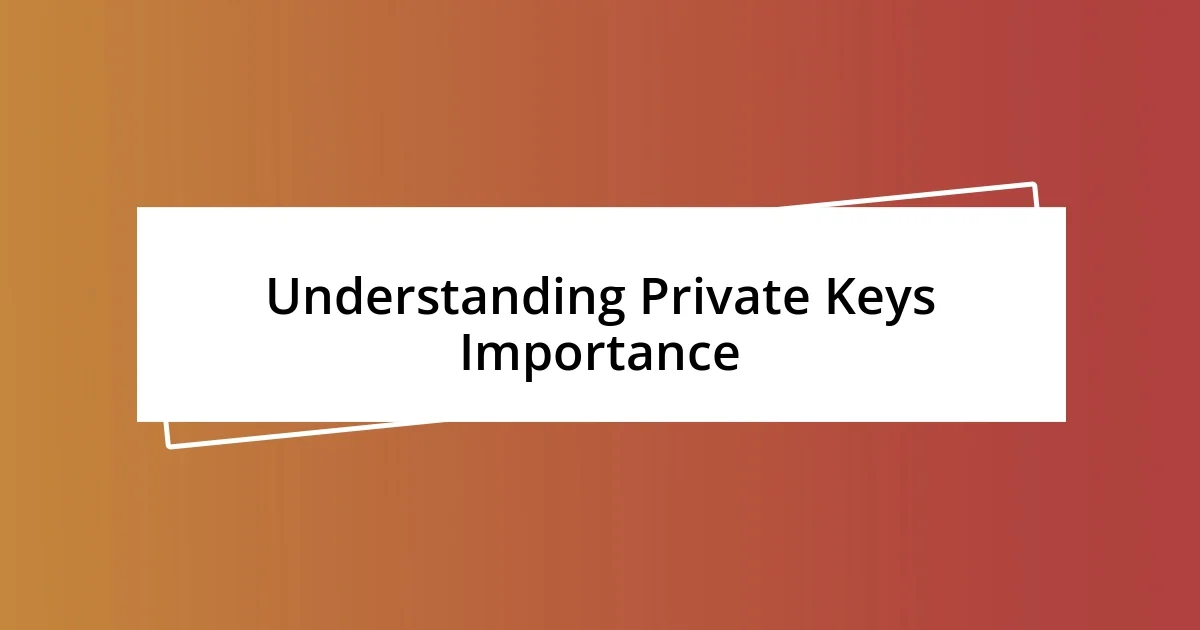
Understanding Private Keys Importance
Private keys are like the keys to your digital kingdom; without them, access to your assets vanishes in the blink of an eye. I remember the first time I mismanaged a key—my heart sank when I realized I couldn’t retrieve my funds. It was a painful lesson that reminded me just how vital these pieces of information are.
Think about it: you wouldn’t leave your house without locking the door, right? Similarly, safeguarding your private keys is essential to keeping your digital assets secure. Each time I encrypt a private key or store it in a secure wallet, I feel a wave of relief knowing I’ve added another layer of protection against potential threats.
Consider the fact that anyone with access to your private keys holds the power over your assets—scary, isn’t it? This thought always lingers in my mind as I navigate the digital landscape. Hence, understanding the importance of private keys is not just about security; it’s about taking control of your financial future and protecting what’s rightfully yours.
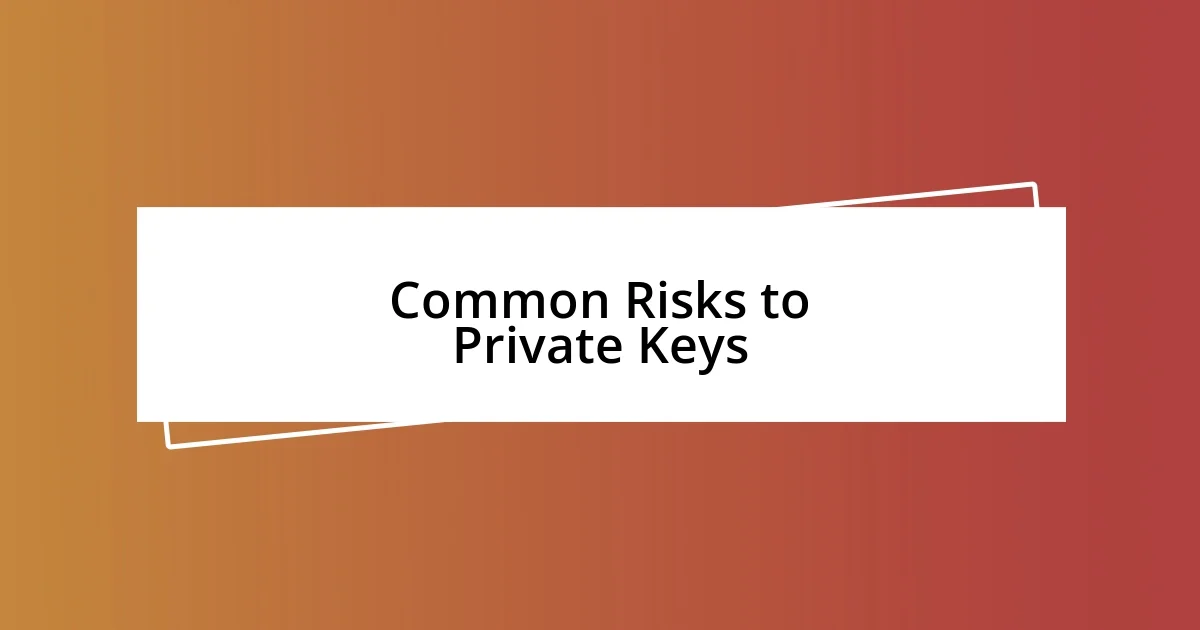
Common Risks to Private Keys
Private keys face several common risks that can jeopardize your digital assets. One major threat is phishing attacks, where malicious actors trick you into revealing your private keys. I’ve received emails that looked legitimate at first glance, and I almost fell for one. It’s a reminder to always verify the source and never share my keys, no matter how convincing the message appears.
Another significant risk comes from malware, which can infiltrate your devices and capture sensitive information. I know someone who lost a chunk of their savings because they unknowingly downloaded a compromised app. This kind of threat underscores the importance of maintaining up-to-date antivirus software and being cautious about what you download.
Lastly, physical theft is another vulnerability. Imagine leaving your hardware wallet on the table during a gathering—now that’s a scary thought! I’ve learned to treat my private keys with the same careful consideration as cash, ensuring they are always stored securely away from prying eyes.
| Risk | Description |
|---|---|
| Phishing Attacks | Tricking users into revealing private keys through fake communications. |
| Malware | Software designed to infiltrate devices and extract sensitive information. |
| Physical Theft | The loss of hardware wallets due to unauthorized access or theft. |
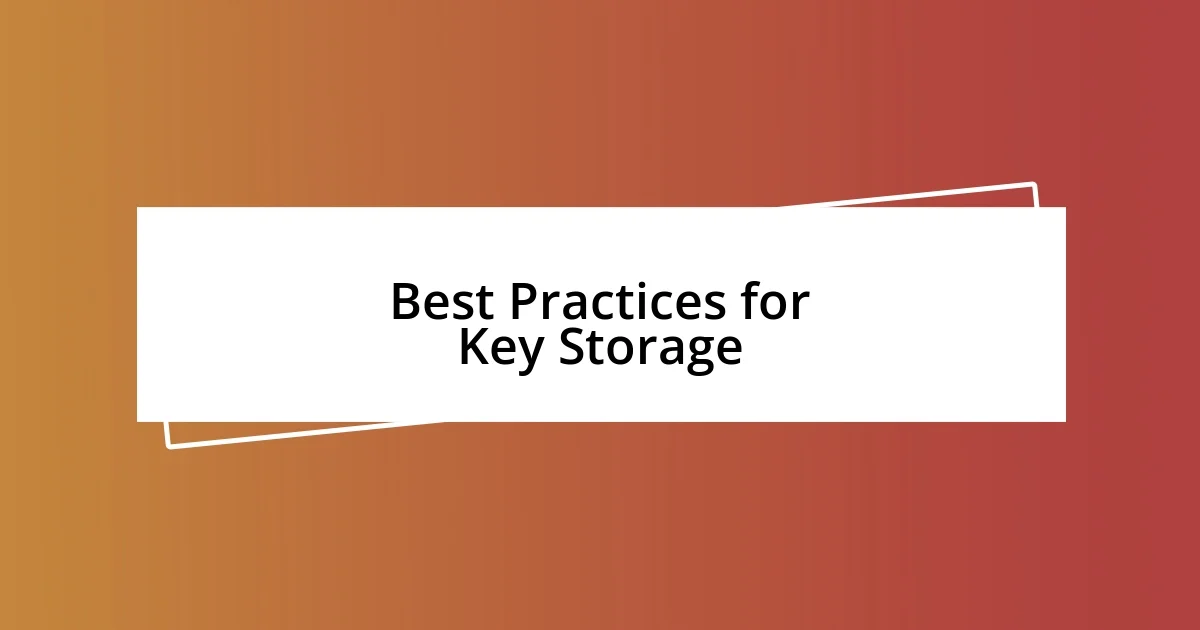
Best Practices for Key Storage
When it comes to best practices for key storage, I can’t stress enough the importance of employing both digital and physical security measures. For instance, I remember my first experience with a hardware wallet—it was like the first time I felt truly secure about my digital assets. However, I quickly learned that even the most sophisticated devices aren’t foolproof. Always encrypt your private keys when storing them digitally, and make it a habit to routinely change your passwords. These steps can make all the difference.
Here are some essential practices to consider:
-
Use hardware wallets: These devices store your keys offline, making them less vulnerable to online threats. I often refer to my hardware wallet as a safe deposit box for my digital assets.
-
Maintain backups: Create secure copies of your keys and store them in different physical locations. I keep mine in a safe at home and also share access with a trusted family member.
-
Implement strong passwords: Always protect access to your wallet with complex and unique passwords. I use a password manager to keep track of mine without the fear of forgetting them.
-
Regular updates: Keep your software and devices updated with the latest security patches. I make it a monthly ritual to check for updates, ensuring I’m always one step ahead of potential threats.
-
Cold storage: Consider storing your keys in cold storage solutions, like writing them down and physically locking them away. There’s something comforting about holding my keys on paper, knowing they are out of reach from viruses and hackers.
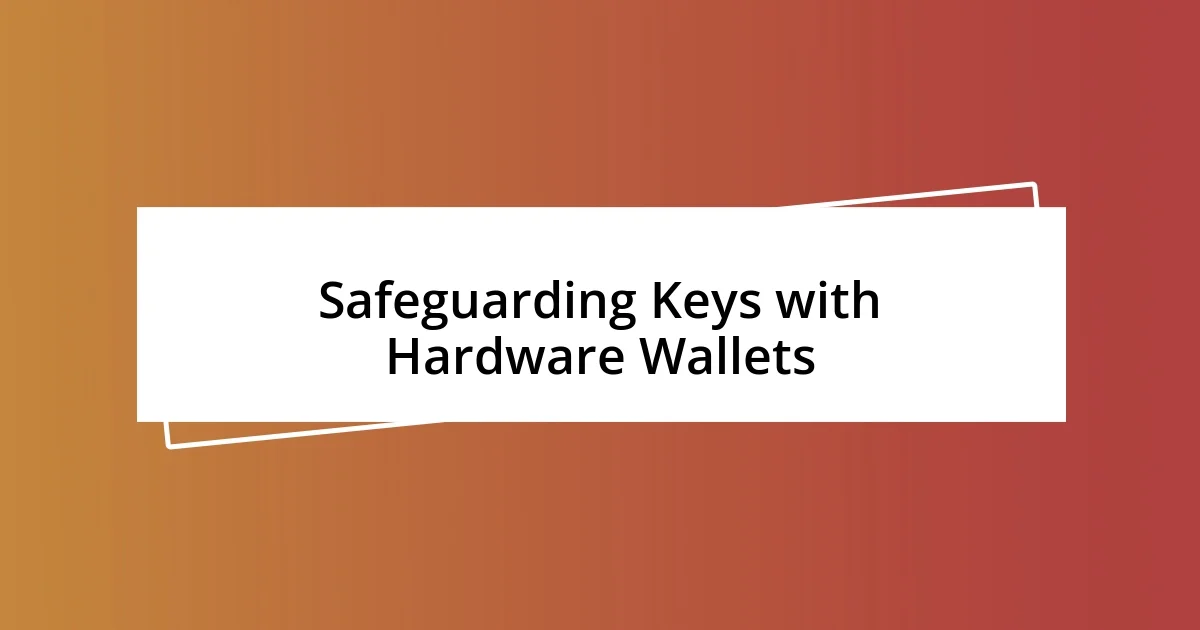
Safeguarding Keys with Hardware Wallets
Using a hardware wallet is one of the best decisions I’ve made for safeguarding my private keys. These devices, often resembling USB drives, keep your keys offline, significantly reducing the risk of online attacks. I remember the peace of mind I felt when I first transferred my assets to a hardware wallet; it was like finally locking my valuables in a safe as opposed to leaving them out in the open.
What I love about hardware wallets is their user-friendly design and added security features, like PIN protections and recovery seed generation. I recall the first time I set mine up; the process was straightforward yet empowering. It’s a little like getting a bank account for the first time; it just feels right to know my assets are stored securely, out of reach from prying eyes and potential malware.
It’s also important to recognize that even hardware wallets need careful handling. I always remind myself not to let my guard down just because I have one; if I lose it or someone accesses it without my permission, the security is all for nothing. I’ve made it a point to have a secure backup of my recovery seed stored in a safe place. Have you ever thought about what would happen if you misplaced your hardware wallet? The peace of mind from knowing I’m prepared for such scenarios is invaluable.
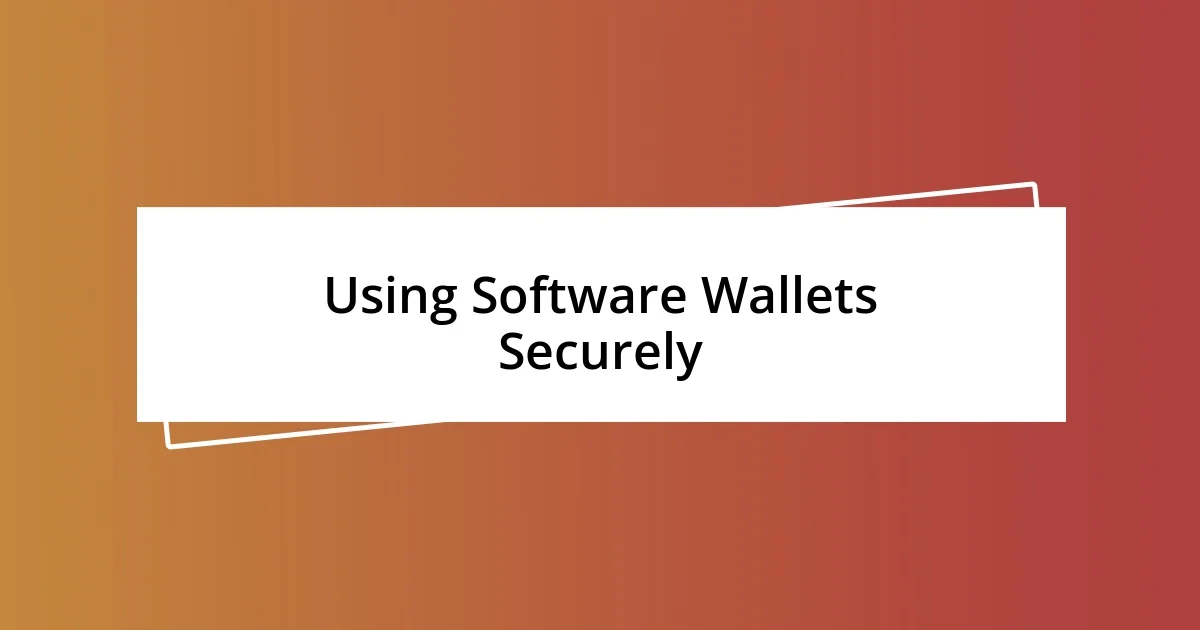
Using Software Wallets Securely
Using software wallets securely requires a proactive mindset. One lesson I learned the hard way was the importance of keeping my wallet software up to date. When I overlooked an update, I noticed some unusual activity in my account, which was a gut-wrenching experience. Now, I prioritize checks for updates as if they’re essential visits to the doctor for my digital health.
It’s crucial to enable two-factor authentication (2FA) for extra protection. I remember implementing 2FA on my software wallet and feeling a wave of reassurance wash over me; that extra step seemed like adding a second lock to my front door. I often ask myself, “What’s the worst that could happen?” If my wallet is compromised, the aftermath could be devastating. That’s why I treat 2FA like my safety net—one I can’t afford to go without.
Being mindful of the devices I use is essential, too. Picture this: I once accessed my wallet on a public Wi-Fi network without thinking. The feeling of vulnerability was immediate! Since then, I’m vigilant about connecting only through secure networks and using a VPN when necessary. It’s made me realize that those seemingly small choices can have significant impacts on my security.
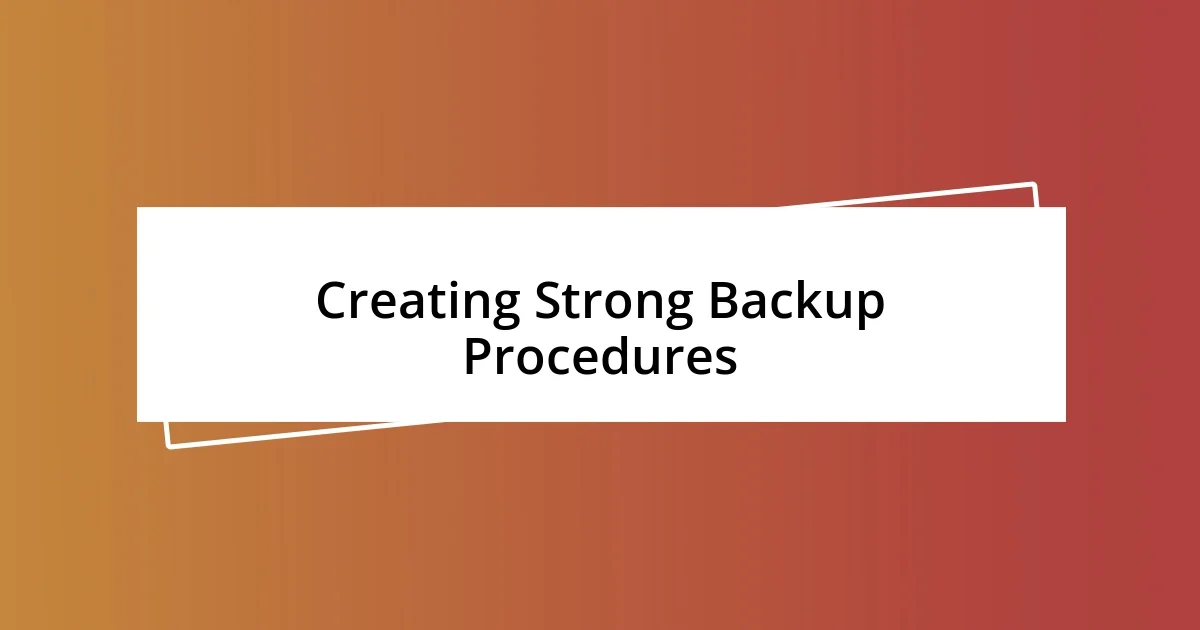
Creating Strong Backup Procedures
Creating strong backup procedures is essential for safeguarding private keys, and I’ve discovered that a multi-faceted approach works best for me. I always create multiple backup copies of essential information, like my recovery seed and wallet files. I vividly remember the relief I felt when I decided to keep one backup in a safe deposit box and another with a close family member. It’s like having a safety net; if anything were to happen to my primary backups, I know I’m covered.
I also make it a point to regularly test my backups. The first time I conducted a restoration test, I felt a rush of anxiety—what if it didn’t work? Thankfully, it did, and the sense of accomplishment was incredible. It’s similar to rehearsing an emergency plan; when you know it works, you can move forward with confidence. Have you ever wondered how confident you truly are in your backups?
Lastly, I always encrypt my backups for an extra layer of security. Knowing that even if someone were to access my backup files, they wouldn’t be able to read them, brings me tremendous peace. I recall setting up encryption for the first time, feeling like I had fortified my digital fortress. Taking these steps ensures that my private keys remain safe, and I can face the future with confidence, rather than fear.
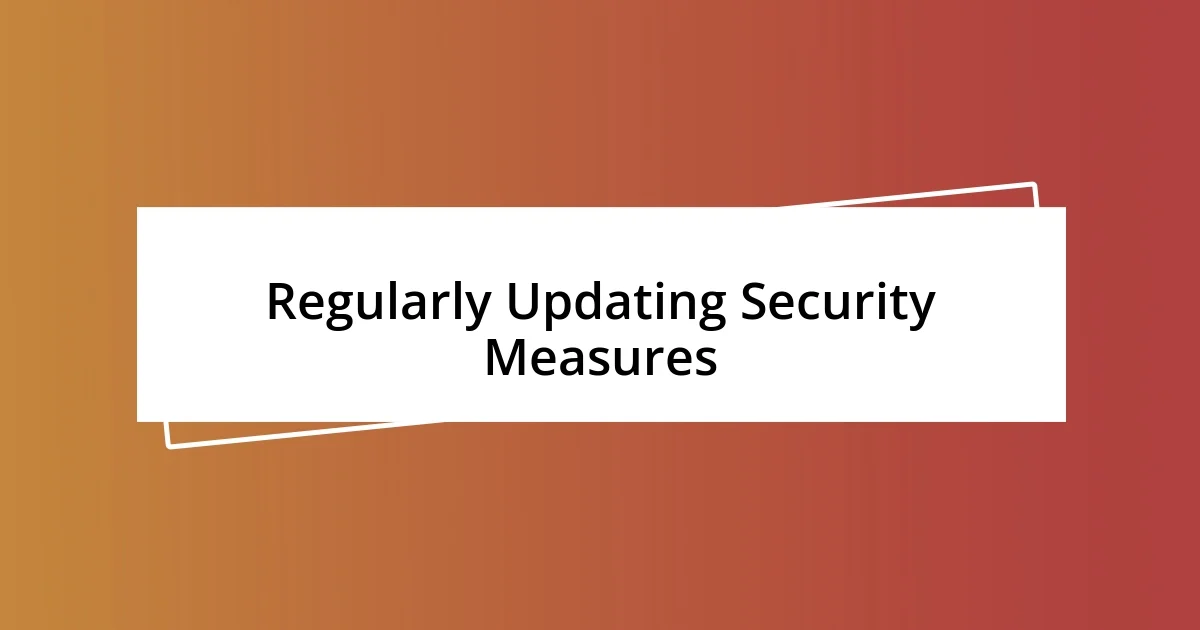
Regularly Updating Security Measures
Regularly updating security measures is something I’ve come to regard as non-negotiable. After experiencing a scare when my antivirus software was out of date, I learned the hard way that vulnerabilities can sneak in when I least expect them. I now look at software updates as a form of protection—a necessary shield against evolving threats. It makes me curious: how many people overlook this simple yet vital task?
Moreover, embracing new security technologies is part of my routine. I remember the first time I switched to a more secure authentication method, and it felt like upgrading from a flimsy lock to a high-tech security system. Each time I come across a new security feature, I think, “Could this be the game-changer?” Constantly exploring better options keeps my digital life dynamic and secure.
Finally, I emphasize the importance of keeping informed about security trends and incidents. There was a time when I felt lost in a sea of tech updates, but subscribing to cybersecurity newsletters turned that around. Not only do I stay alert to potential threats, but I also find myself engaging in conversations with peers about what measures they’re taking. Shared knowledge creates a collective strength—have you shared your security experiences with others? It’s a great way to learn and reinforce best practices.












